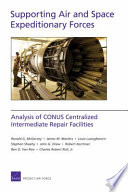
Supporting Air and Space Expeditionary Forces
By - McGarvey, Ronald G , Drew, John G , Kerchner, Robert , ; Luangkesorn, Louis
Floor
-
Floor 1
Published
-
RAND Corp., Santa Monica, CA, 2008
ISBN 10 - 0833042904
ISBN 13 - 9780833042903
Book Status
-
1 Qnty Available with us.
Subject
-
Armed Forces--Facilities
Shelf No
-
19
Call Number
-
358.4183 SUP
Physical Description
-
xxxi, 240 pages : illustrations, maps ; 23 cm
Notes
-
Includes Bibliography